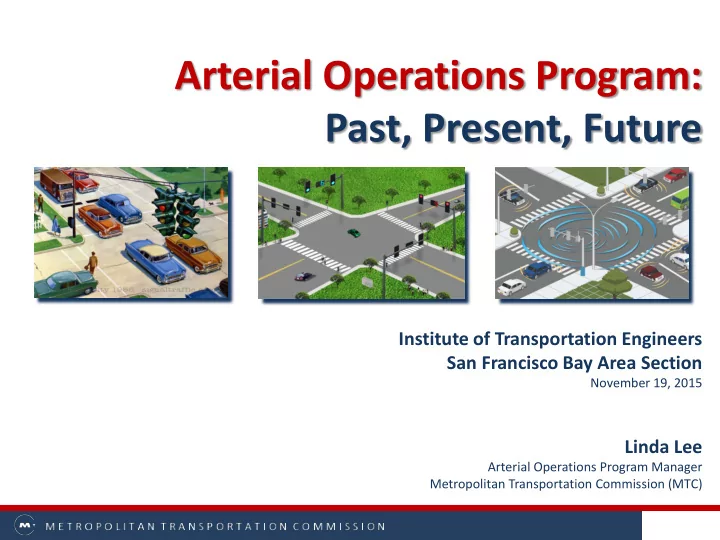

Arterial Operations Program: Past, Present, Future Institute of Transportation Engineers San Francisco Bay Area Section November 19, 2015 Linda Lee Arterial Operations Program Manager Metropolitan Transportation Commission (MTC)
Metropolitan Transportation Commission (MTC) Metropolitan Planning Organization (MPO) Governed by 21-member board Responsibilities include: Planning Coordination Funding Operations San Francisco Bay Area: 9 Counties, 101 Cities 6,500 lane-miles (state highway system) 43,000 lane-miles (local streets/roads system) 10,000 traffic signals (estimated) 2
Arterial Operations Program Elements Technical Assistance Program Annual grant program that provides consultant technical assistance to Bay Area agencies; consultant services are procured and administered by MTC To help agencies improve multimodal mobility and safety along major corridors through signal coordination and other operational improvement projects Arterial Operations Committee Comprised of State/County/Local transportation engineers & planners, consultants, equipment vendors; meetings held bi-monthly Forum for sharing information, developing solutions to shared issues, and guiding the overall Program Technology Transfer Seminars Free, half-day seminars on a variety of topics of interest to Bay Area traffic engineers, planners, consultants, with technical presentations by topic experts Seminars conducted once a year 3
Program Benefits Caltrans City A MTC City B County A Arterial Management Freeway Management Provides Effective Multi-jurisdictional Coordination Arterial Supports Future Produces High-Performing, Connected Vehicle Technologies Cost-effective Results Operations Program Reduces GHG Emissions Provides Transit Benefits through TSP Accommodates Traffic Diversion from Freeways 4
Is the Arterial Operations Program within MTC’s Purview? Per Agency Strategic Plan (2006), programs that would be considered “regional” and within MTC’s purview: Programs that address multi-modal or cross-boundary transportation issues – Arterial improvement projects (e.g., signal coordination and transit signal priority) improve conditions for all modes and along corridors that cross multiple jurisdictions. Programs that have significant impacts on the overall performance of the regional transportation system – Arterials can be considered the foundation of the region’s transportation system, as they serve as important conduits to freeways -- all trips begin and end on a local arterial. Programs that support regional economic development – Arterials provide access to large employment centers, as vehicles access these centers from the freeways or other arterials. Programs that provide unique regional leadership – MTC is uniquely positioned to bring regional consistency, uniformity, effective coordination, and objectivity when implementing projects along arterials that cross multiple city/county boundaries. 5
Technical Assistance Program History PROGRAM TYPES OF PROJECTS Various projects: Traffic Engineering • Signal timing coordination Technical Assistance Program • Traffic studies: feasibility studies, bike/pedestrian safety studies (TETAP) • Miscellaneous services: ConOps, design, etc. Regional Signal Timing Program Signal timing coordination projects only: (RSTP) • Time-of-day (TOD) plans for weekday conditions Signal timing coordination projects only: Program for • TOD plans for weekday conditions Arterial System Synchronization • TOD plans for weekend conditions (PASS) • Flush plans Projects using low-cost advanced technologies: Next Generation • Adaptive signal control systems Arterial Operations Program • Transit signal priority (NG-AOP) • Traffic monitoring using travel time readers FY94 FY95 FY96 FY97 FY98 FY99 FY00 FY01 FY02 FY03 FY04 FY05 FY06 FY07 FY08 FY09 FY10 FY11 FY12 FY13 FY14 FY15 FY16 TETAP (15 yrs) RSTP (7 yrs) PASS (6 yrs) NG-AOP 6
PASS Funding Distribution by County Percentage of Signals Coordinated under PASS FY 2010/11 - FY 2014/15 Sonoma Solano 5% 3% Alameda 24% Santa Clara 22% San Mateo 12% Contra Costa 24% San Francisco 0% Napa Marin 2% 8% 7
Top 10 Recipients of PASS Funding PASS 200 FY2010/11 to FY2014/15 193 180 180 160 140 133 # OF SIGNALS 120 100 95 80 77 73 60 67 65 59 58 40 20 0 Walnut Santa Concord Oakland San Santa South SF Palo Alto Caltrans Livermore Creek Clara Rafael Rosa area County 8
PASS Benefit/Cost Summary PASS Benefit/Cost Ratios FY2010/11 to FY2014/15 90 900 80:1 80 800 67:1 70 700 61:1 BENEFIT/COST RATIO 60 600 # OF SIGNALS 54:1 50 500 41:1 40 400 30 300 $ 1,250,000 $ 1,250,000 $ 2,000,000 $ 1,250,000 $ 1,250,000 20 200 10 100 0 0 FY10/11 FY11/12 FY12/13 FY13/14 FY14/15 Benefit/Cost Ratio # of Signals 9
NextGen-Arterial Operations Program (NG-AOP) Launched in FY2014/15 Builds on the success of PASS Implements low-cost, advanced technologies: Adaptive Signal Control Systems Transit Signal Priority Real-time Traffic Monitoring Queue-jump Lanes Other Innovative Strategies 10
NG-AOP Projects PROJECT OTHER SPONSOR/ CORRIDOR LIMITS PROJECT STAKEHOLDER EST. COST San Leandro Hayward 13 miles AC Transit/ Hesperian Adaptive Signal Control System • Union City 34 signals (ASCS/TSP) $5.5M Blvd. Transit Signal Priority • County of Alameda 27 signals (TSP) Caltrans Adaptive Signal Control System • LAVTA/ 3 miles Dublin Dublin Blvd. Bicycle detection • $1.5M 16 signals Queue jump lanes • Fremont/ 2.2 miles Caltrans Fremont Blvd. Adaptive Signal Control System • $1.0M 9 signals County of Travel time monitoring County 62 miles • Santa Clara/ n/a Expressways 8 expressways Predictive signal timing • $0.75M General Scope of Work: Conduct Systems Engineering analysis Procure system Deploy system Evaluate system performance 11
NextNextGen-Arterial Operations Program (NNG-AOP) Implement Connected Vehicle Pilot Projects Connected Vehicle Technology: Provides wireless connectivity between vehicles, infrastructure, and mobile devices (e.g., smart phones) Provides safety warnings that alert drivers of potentially dangerous conditions (e.g., impending collisions, icy roads, dangerous curves, etc.) — before the driver is aware of them. 12
Benefits of Connected Vehicle Technology 80% 30% Safety Mobility Wireless Connectivity Traffic Data (DSRC, wi-fi, cellular) & Traveler Environment Information $ 15% DSRC = Dedicated Short-Range Communication 13
Example Connected Vehicle Pilot Projects Presents information to drivers about traffic signal Gives priority to transit vehicles approaching a traffic timing; allowing drivers to adapt their speed so signal, taking into account its location, speed, type, they pass the signal on green or decrease speed schedule, and number of passengers. Priority based on to stop in the most eco-friendly way possible. real-time traffic and emissions data to produce the lowest emissions. 14
Arterial Operations Program (of the Future) PASS NG-AOP Beyond NNG-AOP NNG-AOP 15
Linda Lee Arterial Operations Program Manager llee@mtc.ca.gov 16
Recommend
More recommend